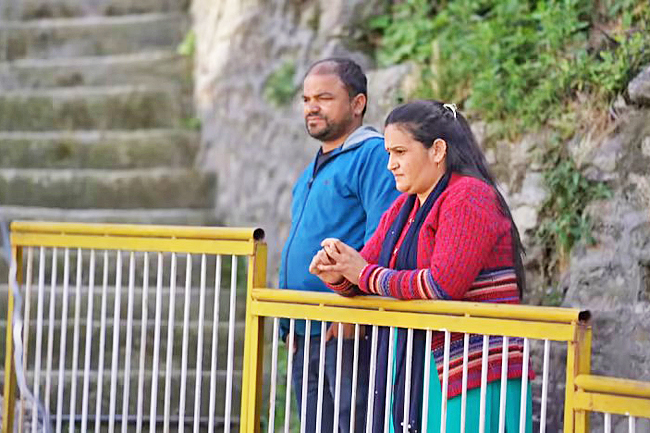UTTARAKHAND, INDIA (CNA) – It was a start to the year that Anjali Rawat and her family did not expect: Having to run for their lives in the middle of the night.
Cracks were appearing in the hotel behind their home in Joshimath town. The hotel windows were falling, an employee informed Anjali’s neighbour.
“They called another neighbour and told everyone to leave their homes because the hotel was falling down,” recalled Anjali, who ran out with her husband Ajay and their son Shivansh, 10.
Months back, cracks had also formed in her home. When her family returned in the morning after they had been forced into the freezing cold, their house “looked the same, but the cracks had increased”, she described. “We heard loud noises, as if an earthquake had struck.
But we didn’t know whether our house would break or sink.”
Next, their balcony collapsed, and one side of the house was “wholly damaged”. They had to move into a temporary shelter provided by the municipal authorities.
What happened in the Himalayan town of Joshimath, in India’s northern Uttarakhand state, was not an earthquake but the earth subsiding. The disaster hit the world headlines as cracks appeared in over 800 buildings, causing many to become unsafe. Some 300 families were forced to evacuate.
Nearly seven months later, residents of the pilgrim town remain unsettled and uncertain about the future – and they are not the only ones, the programme Insight found. The authorities, meanwhile, say they are taking all steps needed to stabilise the hilly areas.



‘VERY, VERY UNSTABLE’
Scientists believe a confluence of factors caused Joshimath to crumble: unstable ground, unfettered urbanisation including a lack of drainage, and the increased presence of water in part due to climate change. Joshimath’s popularity with hikers and pilgrims has led to population growth over the decades, from about 48,000 in 2011 to more than 60,000 now.
Situated at an elevation of about 1,900 metres, it is a stop along the way to Badrinath Temple, one of four revered Hindu shrines. The pilgrimage season, which draws millions of devotees, usually lasts for about six months from April.
The Himalayan range sits atop fault lines, and Joshimath is built on layers of debris left by glaciers and landslides. In the summer, water is released when glaciers melt.
“Because of the impact of global warming, summer is extending, and winter is shrinking.
Snowfall is less, glacial melt is more,” said glaciologist D P Dobhal, a former senior scientist at the Wadia Institute of Himalayan Geology in Uttarakhand’s capital, Dehradun.
Also, when drains are not lined, used water from households and businesses percolates into fissures in the ground. This saturates the soil and makes it “very, very unstable”, said Wadia Institute of Himalayan Geology scientist Swapnamita C Vaideswaran.
“There are hotels, (and) all that water is going into the soil. Where’s that water going? How many (sewage) treatment plants are connected?”
Joshimath, which sits on a layer of sand and rock from an ancient landslide, is not the only Himalayan town or hill station in a precarious state.
About 270 kilometres (km) south, the town of Nainital is similarly vulnerable. Built around a picturesque lake from which a stream called the Balia Nala flows, Nainital has experienced landslides since 1867, including one last year.
“During the last landslide, they shifted 50 families to a school,” said municipal supervisor Rajesh Kshetarya. Residents such as Rajesh are filled with worry during the rainy season each year. It can rain continuously for two days, he said.
After previous landslides, his family had moved uphill. But cracks appeared in his new home.
“We aren’t safe here,” he said. “This area will be in danger if an earthquake strikes. We can’t trust this place where we’re sitting now.”
1976 REPORT WARNED OF RISKS
It has become clear in the wake of Joshimath’s collapse that development had gone ahead despite risks flagged more than 40 years ago.
In 1976, a committee led by Garhwal division’s then commissioner, Mahesh Chandra Mishra, recommended that construction in Joshimath be allowed only after each site’s stability and load-bearing capacity are assessed.
The committee also recommended against removing rocks and boulders at the base of hills in landslide-prone places as well as called for tree planting and the construction of proper drains, among other things.
January’s subsidence turned the spotlight again on major infrastructural works and the lack of rigorous environmental impact assessments. Following public anger and calls by activists, authorities halted work on the Tapovan Vishnugad hydroelectric project as well as ongoing road-widening works.
Some activists believe that the power plant, being built about 15km away on the Dhauliganga river, is a factor. The 520-megawatt project started in 2006, and a tunnel connected to the plant is being dug as well. “We had apprehensions that this would happen if the project continued, and our apprehensions turned true,” said convener of the Joshimath Bachao Sangharsh Samiti (Struggle to Save Joshimath Committee) Atul Sati, citing several of the project’s mishaps over the years.
“Their tunnel boring machine got stuck, and there was water leakage, and the villages near their projects started developing cracks.”
But not all scientists hold the same view, and the plant’s developer – state-owned National Thermal Power Corporation (NTPC) – has denied responsibility. It said the tunnel in question is a kilometre away from Joshimath town and 1.1 km below ground level. Swapnamita agrees.
“I think the Joshimath problem is a surficial problem. It isn’t linked with something happening at such depth,” she said.
ACTION BEING TAKEN – WILL IT SUFFICE?
Even as physical connectivity is important for religious, tourism and strategic reasons, affected residents are looked after, Sinha stressed. On the disaster relief front, the government has “taken care of livelihoods” and residents’ accommodation and offered rehabilitation options, he cited.
“If somebody wants to get money in lieu of the house damaged, … we’re giving them money. And (for) those who opt for a (replacement house), we’ll provide them with houses.”
The government will also prepare “specific construction and development guidelines for all hilly towns”, with development plans and carrying capacity to be based on science, he said.
A “detailed” report has been prepared for a project to stabilise the Balia Nala ravine in Nainital, while geophysical studies of Joshimath are underway, added Sinha.
Given this collaboration between the state government and the scientific community, Swapnamita said: “If this goes on, we can have a better tomorrow.” But are all these measures enough for residents of the Himalayan towns? The future of Joshimath’s people is “in ruins”, declared post office worker and social activist Rekha Devi.
She used to rent out a few rooms to service her home loan, but after Joshimath’s sinking, all the tenants left. Rekha returned to her cracked home as she could not afford to rent a flat.
“How are we supposed to pay off the loan? This is our biggest issue right now,” said the 42-year-old. “Some people are staying in hotels, but for how long? Everyone’s wondering where they’ll go.”
Anjali’s family lived in a municipal building for six months before they had to vacate. They now live in a rented house in Gopeshwar town, about 60km from Joshimath.
Money is tight. The family used to have a restaurant at Joshimath’s market, which did well during the pilgrimage season, she said.
The town would also see tourists on New Year’s Eve. But after the disaster, the restaurant
was shuttered.
They are finding it difficult to restart their lives. “We’re thinking of starting a new business or looking for a new restaurant space either in the Badrinath or Joshimath market. But the rent is too high,” said Anjali. – Neo Chai Chin & Tamal Mukherjee





